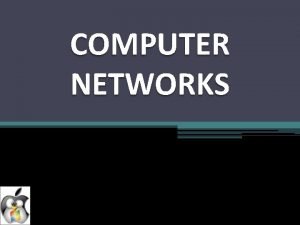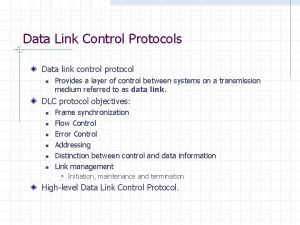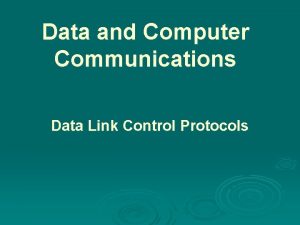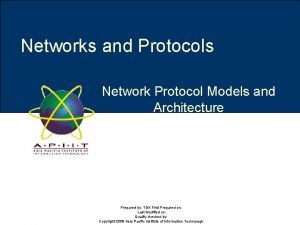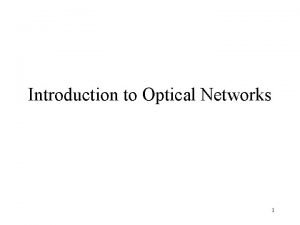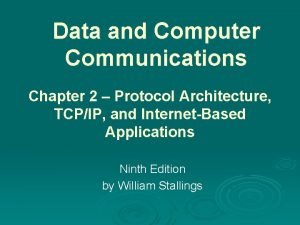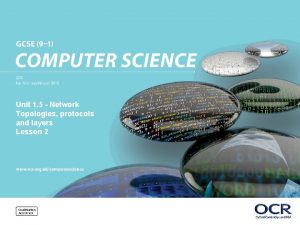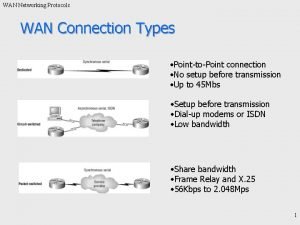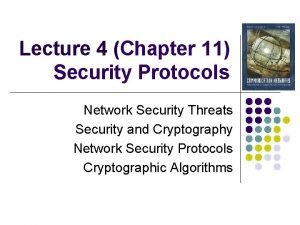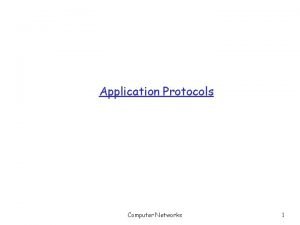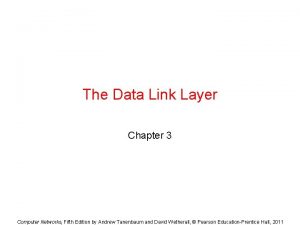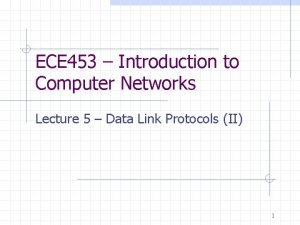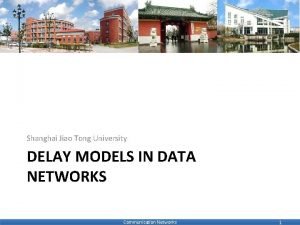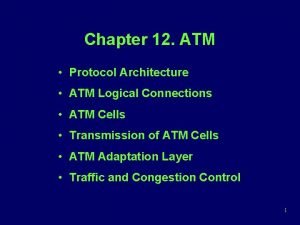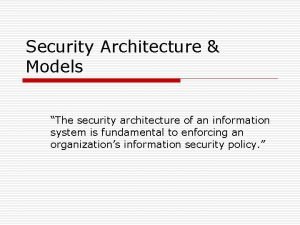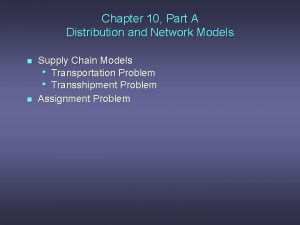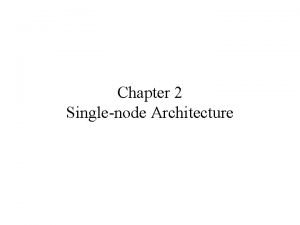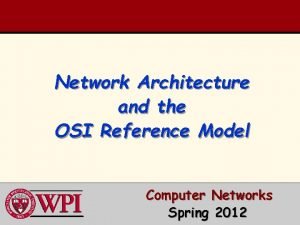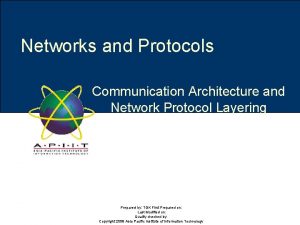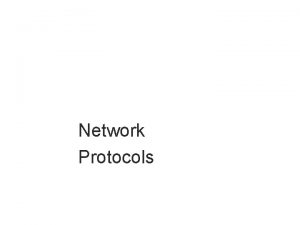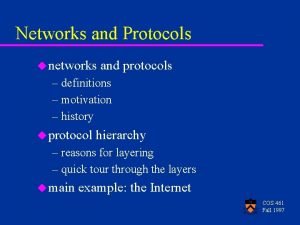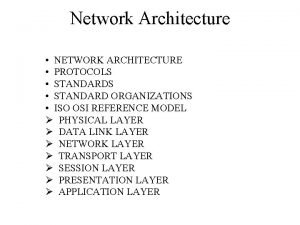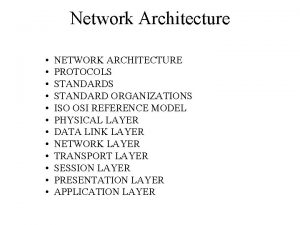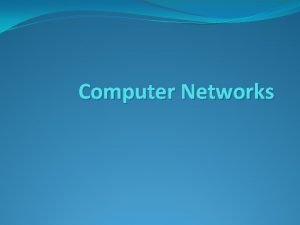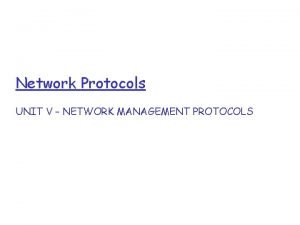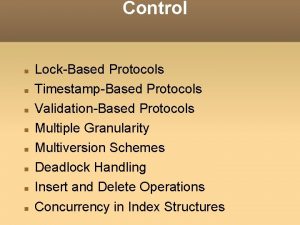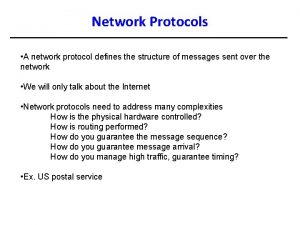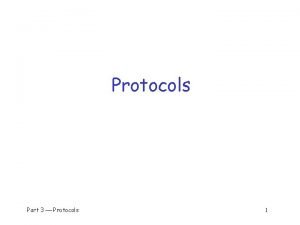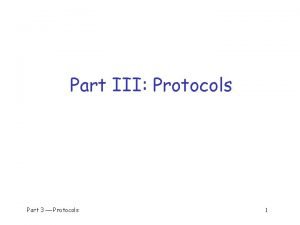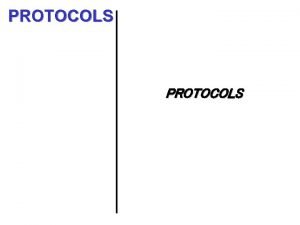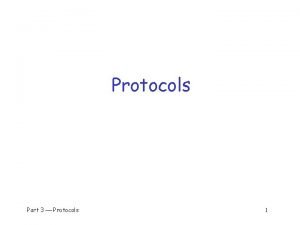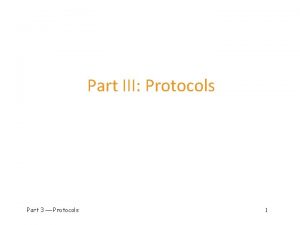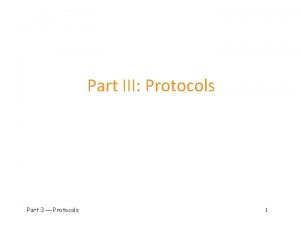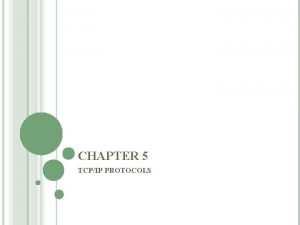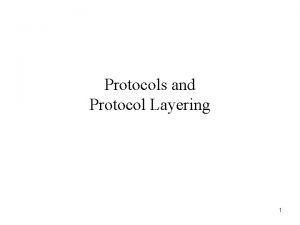Networks and Protocols Network Protocol Models and Architecture































- Slides: 31

Networks and Protocols Network Protocol Models and Architecture Prepared by: TGK First Prepared on: Last Modified on: Quality checked by: Copyright 2009 Asia Pacific Institute of Information Technology

Topic & Structure of the lesson Network Protocol Models and Architecture n n n Networks and Protocols Network Standards and Protocols The ISO-OSI Model Comparing TCP/IP Architecture and the OSI Model Slide 2 of 27

Learning Outcomes Network Protocol Models and Architecture At the end of this module, YOU should be able to: • Explain the importance of Network standards and Protocols • Explain the purpose of the OSI standards model and its contribution to network communications • Explain the purpose of the TCP/IP architecture and the implementation for network communications • Explain the differences between the OSI model and TCP/IP architecture Networks and Protocols Slide 3 of 27

Key Terms you must be able to use Network Protocol Models and Architecture If you have mastered this topic, you should be able to use the following terms correctly in your assignments and exams: • • Reference model Protocol suite Networks and Protocols Slide 4 of 27

Main Teaching Points Network Protocol Models and Architecture • • • OSI Model Layering OPEN communications Communication process TCP/IP architecture Protocols Networks and Protocols Slide 5 of 27

Network Standards and Protocols Network Protocol Models and Architecture • Standards are important, especially to an area such as interconnectivity • In data communications, the International Organization for Standards (ISO) has a proposed standard called the Open System Interconnect (OSI) Model • Complexity of communication system has increased tremendously however, all networks share common functions • ISO has identified and stratified these functions in the Reference Model for Open Systems Interconnection Networks and Protocols Slide 6 of 27

The ISO-OSI Model Network Protocol Models and Architecture • The Open Systems Interconnect • OPEN - means any two systems conforming to the reference model and standards can communicate. i. e. different networks can interconnect • The Model defines a “ Communications Architecture” using a seven (7) layer model which provides a blueprint for building a computer network • Characteristics of the ‘Layer’ Concept • Peer Layer Concept • Entities on each layer communicate with their equivalent on the other side Networks and Protocols Slide 7 of 27

The ISO-OSI Model Network Protocol Models and Architecture • Service Concept • Each layer uses the ‘service’ provided by the next lower layer • Each layer provides ‘service’ to the next higher layer • Independence Concept • Each layer is independent • It carries out its own task independently of other layers • Implementation of each layer is independent within the standards Networks and Protocols Slide 8 of 27

The ISO-OSI Model Network Protocol Models and Architecture • A layer does not care or need to know how the next layer does its job • The OSI layers Application Presentation Session Transport Network Data link Physical Networks and Protocols Slide 9 of 27

The ISO-OSI Model Network Protocol Models and Architecture • OSI communication process Networks and Protocols Slide 10 of 27

The ISO-OSI Model Network Protocol Models and Architecture • OSI layers’ headers and trailer Networks and Protocols Slide 11 of 27

The ISO-OSI Model Network Protocol Models and Architecture • OSI Application layer • Includes functions defined by user • Sometimes application programs must communicate with each other across the network • Content & Format of data exchanged dictated by needs of organization Application Data Date=mm/dd/yy Presentation Session Transport Network Data link Physical Networks and Protocols Slide 12 of 27

The ISO-OSI Model Network Protocol Models and Architecture • OSI Presentation layer • Receiving Application • Has a different set of formatting rules • Uses a different date format • Presentation layer is responsible for translating from one format to another • This can be done by changing: • To a standard transmission format, which is converted by its peer layer / Directly to a format expected by receiving application Networks and Protocols Slide 13 of 27

The ISO-OSI Model Network Protocol Models and Architecture • The Presentation layer operation Application Presentation Data (compressed) Date=dd/mm/yy Session Transport Network Data link Physical Networks and Protocols Slide 14 of 27

The ISO-OSI Model Network Protocol Models and Architecture • OSI Session layer • Establishes connection between applications • Try to re-establish connection if a failure occurs • Enforces rules for carrying on a dialogue between applications • Rules Specify: • Order in which application is allowed to communicate • Pacing of information transfer so as not to overload recipient (flow control) • How to bring session to an orderly conclusion Networks and Protocols Slide 15 of 27

The ISO-OSI Model Network Protocol Models and Architecture • Direction of information flow • The Session layer operation Application Presentation Session ID Transport connection established, Half-duplex, etc Length Data (compressed) Network Data link Physical Networks and Protocols Slide 16 of 27

The ISO-OSI Model Network Protocol Models and Architecture • OSI Transport layer • First layer concerned with world external to its processor • Generates address of end user (the SENDER of data) • Ensures no packets have been lost in transmission and no duplicate packets occur • OSI Network layer • Routes packets - is concerned with the establishing connections across network • Networks and Protocols Collects billing and accounting information Slide 17 of 27

The ISO-OSI Model Network Protocol Models and Architecture • Upon receiving message from Transport Layer the Network layer: § Logs event to the accounting system § Prepares message for transmission to next node on path to destination § Looks up address of next node in Routing Table and appends address § If message is long, divides it into transmission units and appends a sequence number to each unit § Sends each unit Networks and Protocols Slide 18 of 27

The ISO-OSI Model Network Protocol Models and Architecture • The Network layer operation Application Presentation Session Transport Network Routing TSAP Chksum ID Length Header Data Seq no Data link Physical Networks and Protocols address of next network node Slide 19 of 27

The ISO-OSI Model Network Protocol Models and Architecture • OSI Data link layer • Establishes and controls the physical path to next node. Tries to make the physical link reliable, in particular includes: • Error detection and correction • Defining beginning and end of data field • Resolving competing requests for use of shared communications link • OSI Physical layer • Specifies electrical connections between transmission medium and computer system such as: Networks and Protocols Slide 20 of 27

The ISO-OSI Model Network Protocol Models and Architecture • • Number of wires use to carry signals • Size and shape of Connectors • Speed of data transmission (BPS) Comparing the IEEE standards with the OSI Physical layer: OSI Physical (Layer 1) 802. 3 Other 802. 3 10 Base-T 100 Base-T Physical Layer 802. 5 Physical Layer 4 Mbps 802. 5 Physical Layer 16 Mbps Other Physical Layer Multiple Physical Layer Standards Added as technology matures Added if standards creators cannot decide on one Networks and Protocols Slide 21 of 27

Comparing TCP/IP and OSI model Network Protocol Models and Architecture Networks and Protocols Slide 22 of 27

Comparing TCP/IP and OSI model Network Protocol Models and Architecture • TCP/IP Chronology • Late 1960 s: Requirement specified by US Do. D • Early 1970 s: ARPAnet implemented • Late 1970 s: Widespread use in US universities • Mid 1980 s: Commercial use increasing • Early 1990 s: HTTP became largest proportion of Internet traffic • Purpose of TCP/IP • Provides a common communication standard for network devices Networks and Protocols Slide 23 of 27

Comparing TCP/IP and OSI model Network Protocol Models and Architecture • Provides a common communication standard for network devices - mainframes, PCs, workstations, printers, remote devices, telephones, televisions? Provides a framework for interconnection and interoperation regardless of platform or physical network medium Where is TCP/IP used § § § Basic applications: • Telnet (23) – remote terminal session Networks and Protocols Slide 24 of 27

Comparing TCP/IP and OSI model Network Protocol Models and Architecture § • FTP (21/20) – File transfer • SMTP/POP (25/110) – Electronic mail • NFS (Uses RPC) – Network File System • More advanced applications: – HTTP (WWW port 80) Overview • The term TCP/IP is used generically to refer to anything and everything related to the specific network and transport layer protocols: Networks and Protocols Slide 25 of 27

Comparing TCP/IP and OSI model § § § Networks and Protocols TCP UDP IP ARP TELNET FTP Network Protocol Models and Architecture Slide 26 of 27

Quick Review Question Network Protocol Models and Architecture 1. List the major disadvantages with the layered approach to protocols. 2. Discuss the need or lack of need for a network layer(OSI layer 3) in a broadcast network. Networks and Protocols Slide 27 of 27

Follow Up Assignment Network Protocol Models and Architecture Presentation on Layered Model Approach (OSI or TCP/IP) Networks and Protocols Slide 28 of 27

Summary of Main Teaching Points Network Protocol Models and Architecture Networks and Protocols Slide 29 of 27

Question and Answer Session Network Protocol Models and Architecture Q&A Networks and Protocols Slide 30 of 27

Next Session Network Protocol Models and Architecture Topic and Structure of next session • Data Link and Flow Control n § § § Networks and Protocols Overview of Data Link Control and Flow Control Mechanisms Flow Control Techniques Error Detection Techniques Error Control Techniques Slide 31 of 27
 Protocols and standards in computer networks
Protocols and standards in computer networks Data link layer design issues in computer networks
Data link layer design issues in computer networks Elementary data link protocols in computer networks
Elementary data link protocols in computer networks Data link control
Data link control Communication data link
Communication data link Network protocol architecture
Network protocol architecture In a telecommunications network architecture, a protocol is
In a telecommunications network architecture, a protocol is Network protocol architecture
Network protocol architecture Whats my ip
Whats my ip Chapter 3 network protocols and communications
Chapter 3 network protocols and communications Type
Type Network security protocols
Network security protocols Network security protocols
Network security protocols Wireless sensor network protocols
Wireless sensor network protocols Network communication protocols map
Network communication protocols map Virtual circuit tables
Virtual circuit tables Backbone networks in computer networks
Backbone networks in computer networks Internet transport protocol in computer networks
Internet transport protocol in computer networks File sender uga
File sender uga Utopian simplex protocol
Utopian simplex protocol Unrestricted simplex protocol in computer networks
Unrestricted simplex protocol in computer networks A link layer protocol for quantum networks
A link layer protocol for quantum networks Protocol verification in computer networks
Protocol verification in computer networks What is modals and semi modals
What is modals and semi modals Delay models in data networks
Delay models in data networks Atm cont
Atm cont Security architecture model
Security architecture model Distribution and network models
Distribution and network models Single node architecture in wireless sensor networks
Single node architecture in wireless sensor networks Bluetooth architecture in computer networks
Bluetooth architecture in computer networks Osi architecture in computer networks
Osi architecture in computer networks Palo alto certified network security engineer
Palo alto certified network security engineer


